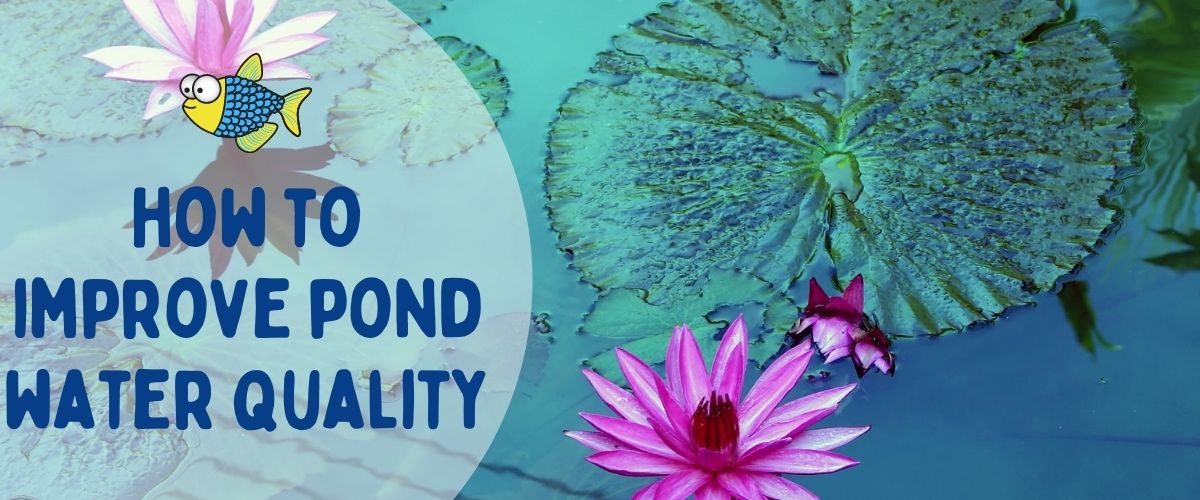Improving pond water quality is key to fish health, and testing should be a regular part of your pond maintenance routine. After all, poor-quality water is the biggest cause of fish stress and illness.
So, how can you improve pond water quality?

How to check pond water quality
We can’t overemphasise how important it is to test your pond water and reveal any abnormalities. The good news is that testing pond water is easy. All you need is a pond test kit, like this pack of TetraPond Quick 6-in-1 Pond Water Test Strips. These strips measure the levels of different nutrients in your pond, like pH, chlorine, ammonia, carbonate, and oxygen.
pH
Testing water quality for pH (the density potential of hydrogen in water) shows you how acidic or alkaline your pond water is. The pH scale ranges from 0 to 14: anything under 7 is acidic, and anything over 7 is alkaline. The ideal range for fish ponds is usually between pH 7 and 8, but this can vary a little depending on what type of fish you have.
Keep in mind that pH fluctuates, so you don’t need to worry if your pond’s pH level changes a little over a few days. However, if your pH is consistently too high or too low, your fish could suffer from acidosis or alkalosis, which could kill them.

Bonus Tip
If your pH is too high, try this Blagdon Alkaline pH Pond Adjuster. And if your pH is too low, try this Blagdon Acid pH Pond Adjuster.


Chlorine
Tap water contains chlorine, which can be fatal for fish. If your pond test shows that there’s too much chlorine in your pond, a Fresh Start treatment should regulate the chlorine levels.
Ammonia
Decomposing organic matter and sludge at the bottom of your pond can create ammonia, which converts into nitrite and then into nitrate. This process is the nitrogen cycle. Your pond bacteria should control these chemicals, but this ammonia remover water treatment can offer bonus help if needed.


Carbonate
Your pond needs high carbonate (hardness) levels to aid the nitrogen cycle and biological filtration. If your carbonate levels are low, try adding rocks around the sides of your pond, a waterfall, or 1 cup of baking powder per 4,500 litres.
Oxygen
Put simply, fish need oxygen to live. But fish waste, decaying organic matter, warm temperatures, and excessive algae can all reduce the oxygen in your pond. In this case, a good-quality air pump can solve the problem.


Other ways to improve pond water quality
Aside from regular testing, there are a few additional steps you can take to improve pond water quality and avoid pond water quality problems:
- The larger the volume of water in your pond, the more stable the water parameters are likely to be. This is because the concentration of pollutants should distribute more evenly in a larger body of water. So, if you can, it’s often a good idea to add more water to your pond.
- Clean your pond filter to make sure it can get rid of dirt and other contaminants effectively.
- Introduce more plants to your pond. Plants act as natural filters, digesting toxins left by fishes and naturally occurring bacteria. It can take months for plants to balance your pond, though, so this is a long-term strategy.
- Aerate the pond to increase the amount of oxygen and sunlight that your pond gets. Aeration also helps remove chlorine from the water and stabilise the pH.
- Add beneficial pond bacteria to the water.
- Clean your pond water regularly and trim dead plant matter to encourage new growth. To clean your pond water, you’ll need a good net and sludge treatment.
- Try to keep under 10 inches of fish for every 100 gallons of water. Many pond retailers will accept fish if your pond is overpopulated.
- Don’t overfeed the pond. Leftover food will only rot and reduce the quality of your pond water.
Most importantly, though, test your pond water at regular intervals.
About Warehouse Aquatics

The Warehouse Aquatics mission is to offer the most choice at the best prices when it comes to your fishes’ wellbeing. We use the products on our website ourselves and are well-versed in all things fish, so we can give you all the advice you need. We’re not just here to sell aquatic supplies. We’re also here to guide you through your journey as a fish owner and enthusiast.
As a small team, we love to hear from our customers, so please do join the Warehouse Aquatics social media community. We’re always up for a chat, and we’d love to share your aquarium photos with our followers.

